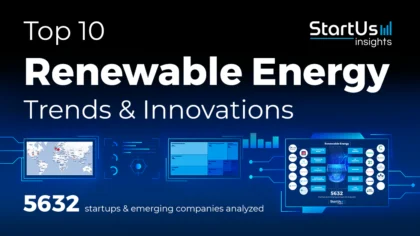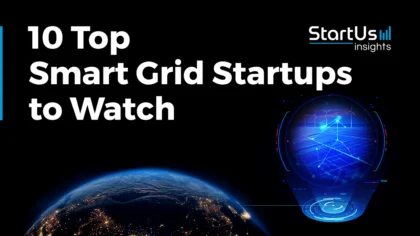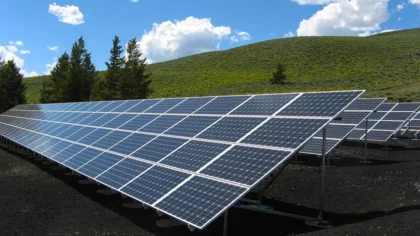According to statistics, there are currently more than 7.000 utility-scale photovoltaic (PV) power plants, with a capacity of almost 180 GW, operating worldwide. Over the last two decades, investment in research and development (R&D) of photovoltaic modules and related solar technologies have reduced costs and continues to do so, for converting and storing solar energy as electricity. Take a look at our Energy Innovation Map to find other clean technology startups.
Compared to solar cells and panels, PV modules and systems have always been more expensive, resulting in a small niche of players developing the technology for utility-scale projects. Permits, licensing, land viability & acquisition, and maintenance, combined with varying government policies result in uneven costs for solar energy adoption in different countries.
How Do Startups Support Utilities In Reducing Costs?
In terms of technology, startups are taking advantage of the research and investment to develop solutions that reduce component costs for photovoltaic power plants. Startups are achieving cost reductions by creating more efficient materials, producing smarter solar tracking, and developing ways to store more energy. With a growing number of incentives and credits provided for clean energy development, experts expect solar energy to become an affordable utility-scale energy staple in the not-too-distant future.
To find out more about how startups support utilities in reducing costs in regards to photovoltaic power plants, we utilized our Innovation Intelligence Platform, covering more than 1.000.000 startups & emerging companies. For this research, we analyzed 65 international startups and emerging companies working on solutions for optimizing and reducing costs for PV power plants.
Some of the criteria we took into account include:
- Relevance of technology
- Maturity Stage of the startup
- Founding Year
- Location of the startup
What You Can Expect
In this article, we highlight important components of a PV power plant and look at 20 innovative startups working on a range of solutions that address all aspects of the power plant. So, here’s what you can expect from this article:
- Insights into photovoltaic systems and its components, e.g. photovoltaic modules, energy storage & battery systems
- Startup & technology information for each component of the PV system explaining how the solutions reduce overall costs for a photovoltaic power plant
- Visual representation of a utility-level photovoltaic power plant
How Startups & Their Technologies Reduce Costs For Photovoltaic Power Plants
Overview
Photovoltaic System
Photovoltaic solar panels absorb light from the sun as a source of energy to generate electricity. They are components of a PV power system using semiconducting materials that exhibit the photovoltaic effect, covering different topics in physics, photochemistry, and electrochemistry.
A photovoltaic module is a connected array of photovoltaic solar cells. PV modules constitute the photovoltaic array of a PV power system that generates and supplies solar electricity for utility-scale, commercial, and residential applications. PV modules are currently in a mature stage of development, with companies trying to maximize output from the modules by incorporating different materials or techniques.
1 | Gigasolar – Lightweight Solar Panels
Based in Silicon Valley, Gigasolar is a US-based company developing lightweight solar panels to accelerate the adoption of photovoltaic technologies. Their non-glass panels incorporate a frameless design and are made using patent-pending composite material, weighing only a third of traditional glass panels. The lighter weight enables easier and cost-effective transportation, lighter mounting structures, and low labor requirements for PV installation.
2 | Praxis Aeronautics – Mobile Solar Energy Modules
Operating from southern Australia, PRAXIS Aeronautics builds solar-powered wings for fixed-wing unmanned autonomous vehicles (UAVs). They employ a proprietary process that integrates solar cells directly inside composite material to maintain the optical clarity of the composite while preserving cell performance. Currently, the startup develops wing PV modules that have gallium arsenide cells or silicon cells for unmanned aircraft systems (UAS). Designed to blend PV modules into different shapes, the modules add negligible weight to the wings while remaining aerodynamic.
3 | Renovagen – Off-Grid Portable PV Modules
A startup hailing from Milton Keynes in the UK, Renovagen, develops PV modules with a patented technology called Rapid Roll. This solution is a high capacity PV power plant with a rollable tow-out solar field that takes just a few minutes to deploy. The PV module is created using a flexible and rollable solar array that behaves as a single piece of ‘mat’ that comes with built-in structural support and embedded cabling for power-transmission. They currently offer the Rapid Roll “T” trailer-scale PV power system that generates up to 16kW of electricity, enough to power a house.
4 | SolarTech Universal – Advanced Cell Connections For PV Modules
Florida, in the US, is home to SolarTech Universal – a manufacturer of ‘next-gen’ PV modules. Their key innovation is the SmartWire Technology (SWT), developed in partnership with Swiss company Meyer Burger. SWT is a novel technique for cell connections in PV module manufacturing. It replaces busbars with 18 micro-wires that gather energy more fluently and strengthen the cells. The startup uses SWT to manufacture EPIQ Solar Panels that have zero potential-induced and low light-induced degradation.
5 | Taiwan Carbon Nano Technology (TNCT) – Fire Resistant PV Module Frames
Taiwanese company TNCT produces carbon nanotubes and graphene in large volumes. Their patented graphene mass-production technology has an annual production capacity of up to 250 tons. They operate in several markets as the materials they develop are applicable across industries. For PV modules, they develop fire-resistant plastic composites that are suitable for module frames. They also develop a range of carbon nanotube dispersion technologies that significantly improve the surface area in energy storage technologies. This enables reductions in the cost of manufacturing functional materials.
6 | Trienergia – Metal Wrap Through PV Modules
Italian startup Trinergia develops high-efficiency PV modules using Back Contact Technology. This technology eliminates the need for welding cells to the module or applying pressure on the cells. A conductive back sheet, metal wrap, in this case, acts as a contact and connection for the positive and negative components of the PV panels. The company offers panels for grid-connected and standalone systems.
7 | Covestro – Specialist Materials & Coatings
A chemicals startup hailing from Leverkusen in Germany, Covestro, manufactures PV modules with patented materials and coatings that integrates into the manufacturing process. They offer panels that are coated with polyurethane elastomers that offer significantly higher durability and resistance to water. The high resistance to abrasions allows for long-lasting panels that require low maintenance, therefore saving money.
Energy Storage
In any photovoltaic power plant, the batteries are a central component of the overall system and significantly affect the cost, maintenance requirements, efficacy, and design of the photovoltaic system. As the adoption rates of solar energy rises, the demand for higher quality energy storage systems that integrate with PV modules also rises. This photovoltaic power plant-plus-storage model enables increased energy storage and higher efficiency in managing renewable grids.
Rapid advancements in battery storage technologies drive down costs and make PV power plants highly efficient. Let us look at two, out of several, battery storage technologies prevalent today.
Lithium-Ion Battery
A lithium-ion battery is a type of rechargeable battery. In these batteries, lithium ions move from the negative electrode to the positive electrode through an electrolyte during discharge, and back when charging. These batteries have a high energy density, no memory effect, and low self-discharge. They are, however, a safety hazard since they contain a flammable electrolyte. It is one of the most popular batteries in use today with applications across mobile phones, consumer electronics, electric vehicles, and energy storage.
Sodium-Ion Battery
A sodium-ion battery is a type of rechargeable battery similar to the lithium-ion. Its working principle and cell construction are identical with that of the commercially widespread lithium-ion battery with the only difference being the sodium compounds. Though these batteries were developed along with lithium-ion batteries, interest in its development has grown in the last two decades, owing mostly to the use of hard carbon as the anode instead of graphite in the battery.
8 | 24M – Nanotechnology Enhanced Lithium-Ion Battery
The US-based company 24M designs and develops nanotechnology-enhanced lithium-ion batteries, making them cheaper and more reliable. The materials design of these batteries allows for a significantly higher electrode capacity compared to existing technologies. A flexible cell format enables the application of this energy storage technology across large and small grids, electric vehicles, and other consumer electronics.
9 | Brenmiller Energy – Thermal Energy Storage
Israeli company Brenmiller Energy develops thermal energy storage solutions for industrial and large-scale power plants, among other industrial applications. Their bGen storage solution for existing photovoltaic power plants or standalone energy storage sites is designed for load shifting and replacing peaker-plants. The company provides thermal energy storage solutions for other applications like waste-heat recovery, electricity-to-heat, and biomass-to-heat.
10 | Elestor – Hydrogen Bromine Flow Batteries
Dutch startup based out of Arnhem, Elestor, develops hydrogen bromine flow batteries to accelerate low-cost energy storage solutions. Hydrogen and bromine are abundantly available in the world, unlike lithium or cobalt, and allow for higher energy density. Their storage systems are fully reversible and do not need human intervention to replace chemicals. This enables a self-contained storage system that is charged and discharged easily.
11 | Teraloop – Kinetic Energy Storage System
Based in Espoo in southern Finland, Teraloop is a startup developing kinetic energy storage systems using a combination of electromagnetic technologies. First, they use magnetic levitation to optimize the storage system for passive levitation, which boosts energy efficiency. Second, they use electromagnetic stabilization to reduce friction by judiciously using the materials. And third, they use permanent magnet synchronous technology to maximize power density.
12 | Yotta Solar – Scalable Smart Energy Storage
Set up in Austin, the US-based startup Yotta Energy develops innovative solar energy storage solutions. Their flagship product, SolarLEAF, is a modular storage solution with smart thermal regulation that integrates each PV module while maximizing the life of the battery. The compact and scalable storage system incorporates a plug-and-play design that is connected to their energy software solution Yotta Energy Services (YES). This solution eliminates the need for complex HVAC and advanced fire suppression systems that are usually required for existing power plants.
Tracking & Mounting
Photovoltaic mounting systems, also known as solar module racking, are used to fix solar panels on surfaces like roofs, building facades, or the ground. Modules are assembled into arrays on a type of mounting system, which may be classified as ground-mounted, rooftop-mounted, wall-mounted or floating. The mount is either fixed or dynamic and uses a solar tracker to follow the sun across the sky.
A solar tracker is a device that orients a payload toward the sun. Payloads are usually solar panels, parabolic troughs, fresnel reflectors, lenses, or mirrors of a heliostat. Trackers are also used to minimize the angle of incidence between the incoming sunlight and a photovoltaic panel, sometimes known as the cosine error. Reducing this angle increases the amount of energy produced from the installed power plants.
13 | Tessolar Inc – Integrated Racking Solutions
A startup operating from Austin, USA, Tessolar Inc. develops the Tesserack line of integrated racking products for PV systems that accelerates the installation process. These PV module racks are made with aerospace-quality composite materials that allow for high-precision engineering. Their patent-pending SolidSnap technology provides tool-free, high throughput PV system installation, with precise snap-fit joints, that meet or exceed PV industry standards for strength, durability, and safety.
14 | GameChange Solar – Fixed-Tilt Mounts & Trackers
New York-based startup GameChange Solar manufactures fixed-tilt and tracker solar racking systems for PV power modules. Their flagship mounting and racking system, MaxSpan-X, allows for significantly faster installation with reduced labor requirements while their patent-pending articulating purlins allow for advanced terrain adjustability. The Genius Tracker uses artificial intelligence (AI) to interact with clouds and minimize stow to optimize power & output. Individually powered trackers allow for variable lengths to optimize panel density and row spacing.
15 | Insolight – Planar Optical Micro-Tracking
Based in Lausanne in Switzerland, Insolight is a startup that designs and develops PV modules by incorporating their patented planar optical micro-tracking technology to maximize power output during days without much sunlight. An embedded optical layer concentrates light beams directly onto PV cells that ensure that the cells receive maximum light, irrespective of the sun’s position. This layer is made from a polymer with high resilience to UV light exposure and the space-grade PV cells are also resilient to extreme radiation and temperature.
16 | Sunfolding – Single-Axis Trackers
Operating from San Francisco in the US, Sunfolding develops photovoltaic power plant solutions that enable fast and easy design, installation, and operations using their flagship tracker, the T29. This tracker features Sunfolding’s AirDrive technology, which uses the strength and resilience of wear-free automotive components to replace problematic tracker motors, gearboxes, and other wear-tear surfaces. The tracker combines a streamlined and robust design, fewer components, and greater flexibility in choosing layouts.
Central Inverter
A central inverter is a critical balance of system (BOS) component in a photovoltaic system that enables the use of ordinary AC-powered equipment to run on the DC power generated. Solar power inverters have special functions adapted for use with photovoltaic arrays, including maximum power point tracking and anti-islanding protection for utility workers’ safety.
Automation & Robotics
Well designed robots and AI-powered automation software drive improvements in PV manufacturing, operations, and maintenance. Several startups and emerging companies develop smart solutions to handle complex issues like human error or contamination of PV modules during manufacturing, or the large volumes of water currently necessary to clean solar panels.
17 | Alencon Systems – Central Inverter
The US-based company Alencon Systems develops solutions to help utility-scale PV operators harness more of the sun’s energy and reduce the Levelized Cost of Energy (LCOE) produced from a power plant. At the heart of their solution is the Grid Inverter Package (GrIP) central inverter, which scales up to the multi-megawatt level in 2.5 MW increments. The GrIP system is based on their patented Harmonic Neutralization approach, an upgrade from the pulse-width modulation (PWM) technology used by PV inverters today.
18 | Ecoppia – Robotic Solar Cleaning
Israeli company Ecoppia develops robotic solutions for PV, offering a cloud-connected platform to maximize the performance of utility-scale PV power plants. The automated robotic systems use big data, machine learning, and automation to periodically remove dust from panels. The company offers data-driven autonomous robotic cleaning solutions for fixed-tilt and single-axis mounts and trackers. Their solutions require extremely low volumes of water, are self-powered and incorporate cleaning microfiber elements onboard the PV module.
19 | AMPT – String Optimizers For PV Modules
A group of panels that are wired into a single input in the power inverter is called a string. Energy efficiency, to a certain extent, depends on the number of strings connected to an input source. US-based company AMPT develops string optimizers that enable string-level power management. The compact devices are DC-to-DC converters used to improve performance and lower costs for new PV power systems. This technology enables low-cost DC-coupled solar plus storage solutions and improves operations and maintenance of PV systems.
20 | SoloGrid – Off-Grid Electricity Solution
Many communities around the world cannot afford single home solar solutions and, at the same time, are too small for installing expensive micro-grids. Hailing from San Ramon, in the US state of California, and with an office in Kampala in Uganda, SoloGrid develops a plug and play solar power hub that collects, converts, stores, and distributes renewable energy to essential institutions like schools. SoloGrid power hubs provide both AC & DC power, allowing for the use of a wide variety of devices and appliances.
What’s To Come?
Startups and investments focusing on photovoltaic power plants, and the broader solar industry, aim to reduce costs across the PV value chain. It is now growing apparent that energy storage is set to play a major role in driving down costs. Energy storage and energy efficiency startups are already disrupting the utility sector by offering longer-lasting and low-waste energy storage systems – in turn accelerating demand for the adoption of renewable energy, like photovoltaics.
Many startups focus on mounting, tracking, and automation solutions for the industry. They are developing innovative ways of increasing power output by simply dealing with the movement of the sun and maintaining modules in better condition. The PV module industry is comparatively more mature, having been under research and development for several years and even decades. However, it comes down to the efficiency of these PV panels to constantly be able to generate and store higher amounts of power.
Solar photovoltaics is one of several renewable energy technologies that are rapidly changing the way we generate and consume energy. Learn more about other technologies in Wind, Solar, and Kinetic Energy or get in touch with us to find out more about the renewable and clean technologies that interest you.


![Dive into the Top 10 Energy Industry Trends and Innovations [2025]](https://www.startus-insights.com/wp-content/uploads/2025/03/Energy-Trend-SharedImg-StartUs-Insights-noresize-420x236.webp)






